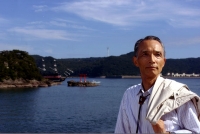|
Read works of Morimura Seiichi at 小说之家 |
The Devil's Gluttony was serialized in the Akahata (Japanese Communist Party's newspaper) in 1980, and subsequently published by Kobunsha (光文社), in two volumes 1981 and 1982. In the ensuing controversy, half of a photograph was discovered to be a fabrication, and Kobunsha subsequently withdrew the book. A second edition was then published by Kadokawa Shoten in 1983 with the controversial photograph removed.
He won the Edogawa Rampo Prize in 1969 for "Death in the High-Rise".
His short story: "Devil of a Boy" appears translated into English in "Ellery Queen's Japanese Golden Dozen: The Detective Story World in Japan" anthology, which was edited by Ellery Queen.
Reference
^ a b [+The+Devil's+Feast...+&pqatl=google "The Devil's Feast..."]. Boston Globe. April 20, 1982. Retrieved December 7, 2010.
^ "Japanese public reliving war". Pittsburgh Post-Gazette. March 15, 1982. Retrieved December 7, 2010.
^ Croddy, Eric (1997). Chemical and biological warfare: an annotated bibliography. Scarecrow Press. p. 18. Retrieved December 7, 2010.
^ Nozaki, Yoshiko (2000). Textbook controversy and the production of public truth: Japanese education, nationalism, and Saburo Ienaga's court challenges. University of Wisconsin--Madison. Retrieved December 7, 2010.
^ Gid Powers, Richard; Hidetoshi Katō, Bruce Stronach (1989). Handbook of Japanese popular culture. Greenwood Press. p. 283. Retrieved December 7, 2010.
